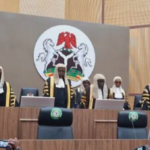Tomato is one of the vegetables grown significantly in many states of the north. Unfortunately, farmers have incurred huge losses in recent years due to diseases that continue to ravage farms.
Experts have suggested few steps farmers should take if your farm is affected in order to reduce the economic effect of these viruses and fungi.
Professor Tunji Arokoyo of the National Agricultural Extension and Research Liaison Services, Zaria advised farmers to adopt good cultural practices by removing the ones that have been affected by diseases to avoid contact with others.
He also said farmers need to reduce the water intake particularly where farmers are using irrigation.
Professor Arokoyo stated that planting tomatoes is not the best during rainy season unless you have a greenhouse where you can keep-off the insects and the pests, adding that if you must plant, you have to spray. You know it is edible both raw and cooked, so you have to be watchful of what you spray and how you spray.
“It will be better if we can move to green houses where we can produce high value crops under control conditions. We are having demonstration over the high cost of green house because we are growing different types of vegetable there,” he said.
Dr. John Okwudili Ene is a consultant, Development Horticulturist and principal partner, Horticulture Development Centre, Abuja. He said the disease that affected tomato in the north is Tuta.
Tuta
He said the disease can be controlled by agro chemicals but stressed that most of the agro chemicals farmers used are adulterated, which make the disease to defy treatment and control.
He stated that the best solution now is to change to diseases resistant varieties which they are trying to bring in from Israel and Holland for onward distribution to farmers.
Bacterial and Fusarium wilts
There are no effective chemical controls. When the plants die, the pathogen is released into the soil, so it’s imperative that you remove diseased plants immediately. Do not compost the diseased plants!
Like professor Arokoyo said, good cultural controls are the best. Farmers should not allow running water in their farms because it can spread the disease to other parts of the farm
The beds for planting the tomatoes should be raised to improve drainage and control root knot nematodes, which make the plants more susceptible to disease.
Tomato should be properly space enough to provide good air circulation.
Early blight
The farmers should always remove old plant debris and do not compost. Keep leaves of tomato plants from touching the ground.
Late blight
The first line of attack against late blight is for immediate removal and destruction of any infected plants. The plants should then be either burned or bagged and discarded through normal garbage disposal means.
Molds
Where a farmer grows the tomato in an open field not (greenhouse), avoid wetting the leaves when watering the plants. Earlier watering is optimal because it allows the plant time to dry when the sun comes, keeping humidity around leaves to a minimum.
Septoria leaf spot:
Leaves on the lower branches of tomato plants are typically affected with brown spots, followed by yellowing or browning of the leaves. Wet weather may encourage the disease to progress up the plant.
Here, the affected farmer should remove the infected leaves as soon as he noticed them to avoid spread.
Insects:
To control insects, farmers are to remove weeds from around the parameters of the tomato plants because they are perfect breeding grounds for insects.
Treatment and control of some tomato diseases
Tomato is one of the vegetables grown significantly in many states of the north. Unfortunately, farmers have incurred huge losses in recent years due to…


